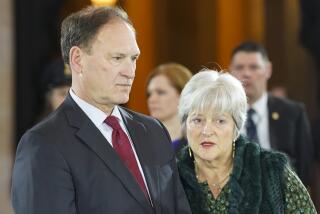High court is no longer above meeting the press
- Share via
WASHINGTON — There’s Antonin Scalia chatting with Lesley Stahl on “60 Minutes.” There’s Scalia speaking at length on National Public Radio. And there he is again, taking questions from high school students on C-SPAN.
Picture Greta Garbo joining Facebook, and you get the idea.
Until now, the Supreme Court justice has been notoriously averse to associating with the media. He has often excluded them from public appearances, even barring C-SPAN from covering an award he received in 2003 for protecting freedom of speech. In an incident a year later, federal marshals guarding Scalia at a speech in Mississippi confiscated and erased a reporter’s tape recorder, deleting the justice’s comments. Then, in 2006, he brushed away a Boston reporter with a gesture that some said was obscene.
But this apparently is a new day, and not just for Scalia, but for other members of the high court.
Seven months ago, Justice Clarence Thomas, a fierce critic of the media ever since Anita Hill’s sexual harassment allegations against him during his 1991 Senate confirmation hearings, also appeared on “60 Minutes,” tooling around in his RV with correspondent Steve Kroft. He also took ABC’s Jan Crawford Greenburg to a football practice at the University of Nebraska, and he sat down with conservative talk show hosts such as Rush Limbaugh and Sean Hannity.
Thomas’ turnaround may be even more stunning than Scalia’s. After all, not only has he resisted speaking to the media, he hasn’t even said a word during oral arguments in more than two years.
But then again, Thomas, like Scalia, had a book to promote.
Traditionally, Supreme Court justices rarely gave interviews and never appeared on television. Information about the inner workings of the court was zealously guarded. The clerks who worked for the justices were sworn to secrecy, and when a behind-the-scenes book occasionally emerged, it was often viewed as unseemly.
For most Americans with an interest in the court, their only chance to watch a justice talk about himself or his judicial philosophy was during his Senate confirmation hearing, before he or she was on the court.
But there are signs of a thaw. Justice Ruth Bader Ginsburg appeared on the “60 Minutes” segment on Scalia, talking about her friendship with him. Justice Stephen G. Breyer has given interviews to NPR and CNN. A profile of Justice John Paul Stevens appeared last year in the New York Times Magazine, and Justice Anthony M. Kennedy recently granted an audience to Newsweek. Chief Justice John G. Roberts Jr. appeared in a PBS documentary on the court.
Carl Tobias, a law professor at the University of Richmond, says the court may be entering a new era.
“The development seems to be a healthy one,” he said, “and should help educate the public about the court and its work.”
In his recent series of interviews, Scalia has shown himself to be engaging, self-effacing, even charming -- far from the reputation he enjoys as a constitutional “originalist” who bullies the lawyers who argue before him.
But he is still Scalia, with his opinions as firmly held as ever.
“I can be charming and combative at the same time,” he said on “60 Minutes.” “What’s contradictory between the two?” He told Stahl that critics of the court’s ruling in Bush vs. Gore, the controversial 2000 case that handed the presidency to George W. Bush, should just “get over it.”
Edward Lazarus, a former Supreme Court clerk and the author of a book on the court, said that Scalia showing a public face shouldn’t be surprising.
“He’s engaged in a war of ideas,” Lazarus said. “The force of his personality is a significant weapon in that war.”
As to why Scalia, who has been on the court for 21 years, has decided that now is the time to raise his profile, Lazarus would only speculate.
“I think former Chief Justice William H. Rehnquist frowned on this a bit more than Roberts does. I just think the boundaries have moved.”
The new openness may have begun with former Justice Sandra Day O’Connor, who as a former state politician, was more comfortable in the limelight.
She became more willing to speak to the media near the end of her tenure on the court. She’s also been the author of several books and was the subject of a bestselling biography.
Since retiring in 2005, she has been an active, high-profile ambassador for the American legal system, having the kind of post-court career rarely, if ever, seen before.
But even as the court moves toward greater transparency, it continues to resist televising its proceedings.
Last year, an effort was again launched in Congress to push the court to allow cameras into its chamber. But Kennedy showed up on Capitol Hill to urge senators to abandon the idea.
More to Read
Sign up for Essential California
The most important California stories and recommendations in your inbox every morning.
You may occasionally receive promotional content from the Los Angeles Times.










